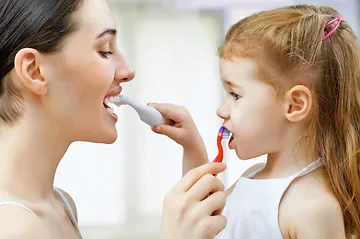Tooth decay is the most common chronic disease affecting kids, and unfortunately, children who develop cavities in their baby teeth are more prone to develop cavities in their permanent teeth as well.
How to protect children’s teeth from decay?
Prolonged exposure to sugar-containing liquids can cause tooth decay, so limit your child’s consumption of beverages containing sugar, such as soft drinks, sports drinks or sweetened fruit juices. If you give your child a sippy cup for long periods of time, fill it only with water and do not allow your child to take it to bed. Children should be encouraged to drink from a regular cup as early as possible, since it minimizes the duration of time that liquids are in contact with the teeth. You should also limit your child’s consumption of sugary or starchy snacks, especially those that can remain stuck to or in between the teeth after eating.
When should my child see a Dentist?
It’s a good idea to start bringing your child to the Dentist on a regular basis by the age of two, unless you notice obvious dark spots on the teeth before that time. Early visits help familiarize your child with the dental office, reducing anxiety and making future visits less stressful. At your child’s visits to our office, we would examine the health and development of their teeth and mouth and review good and preventive oral health habits which should reinforce your teachings at home. Feel free to bring your children to your dental cleaning appointments, in order for them to see that mom and dad also get their teeth cleaned.
What can I do to improve my child’s oral health at home?
Parents should care for their child’s oral hygiene until the child is old enough to take responsibility for the daily routine of brushing and flossing. Parents should also closely monitor and supervise their child’s oral hygiene practices, after they have assumed responsibility for these tasks.
To promote good oral health, we recommend:
- Make sure your child brushes his or her teeth for two minutes (use a timer) twice a day. Children 2 years and older can use a half-pea sized amount of fluoridated toothpaste. Encourage your child to expectorate the toothpaste/foam at a young age and to not swallow the toothpaste foam. Before your child turns 2, clean his or her gums and teeth with a damp cloth and brush the teeth using a soft-bristled toothbrush and water.
- Start flossing between your child’s teeth as soon as he or she has two teeth that touch each other.
- Monitor excessive sucking of pacifiers and fingers, since these habits can lead to future misalignment of teeth when continued past the age of two.
- Since our water in Central Oregon is not fluoridated, give your child supplemental fluoride by six months of age. Fluoride is available in both a liquid and chewable form, so it can be easily dispensed regardless of the age of the child. When used properly, fluoride has been shown to reduce the rate of decay in children and adults.
- Make sure your child avoids eating after he or she has brushed their teeth at night, to prevent food and debris from being in contact with their teeth through the night.
- Encourage your child to brush and floss their teeth when they are old enough, but always monitor the child’s technique and thoroughness.
- Lead by example: brushing and flossing your teeth with your child will teach him or her to understand the importance of good oral hygiene.
- Regular and early visits to the dentist help promote and educate the child about good oral hygiene practices. It also helps screen and treat potential issues or problems before they become more serious or widespread.
- Cavities are a bacterial disease and parents who have a lot of untreated cavities in their mouth, have a higher chance of passing the bacteria to their children through the sharing of cups, straws and spoons. It is important for parents to treat any dental disease they have, in order to minimize the risk of transferring decay causing bacteria to their children.


